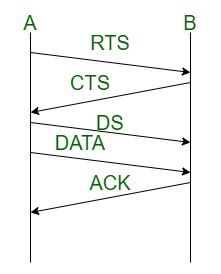MACAW Protocol
Last Updated :
13 Aug, 2020
Multiple Access with Collision Avoidance for Wireless (MACAW) is a medium access control (MAC) protocol broadly utilized in ad hoc network systems. Besides, it is the establishment of numerous other MAC protocols utilized in wireless sensor systems (WSN).
The IEEE 802.11 RTS/CTS system is received from this protocol. It utilizes RTS-CTS-DS-DATA-ACK frame succession for moving information, once in a while went before by a RTS-RRTS frame arrangement, in view to give answer for the concealed node problem. Although protocol dependent on MACAW, are S-MAC, MACAW doesn’t utilize carrier sense.
Features :
- The problem in MACA that if there are two sender and two receiver A, B, C and D respectively.
- If B has send RTS to C and D at the same time and but only send data upon receiving CTS from C.
- Now A wants to send data to D but will not able to send because it will sense that D is currently busy and will increase the backoff counter (for how much time A will wait before re-transmitting) value by twice because of which it will get stuck in a loop until the D gets free.
- Blockage data trade between pairwise stations, prompting better clog control and backoff approaches

Advantages over MACA :
- The sender detects the bearer to see and transmits a RTS (Request To Send) if no close by station transmits a RTS.
- The fairness of MACAW is much better than MACA.
- It handle hidden and exposed node problem better than MACA.
- ACK signal is send to the MAC layer, after every data frame.
- It also incorporate carrier detecting to additionally diminish collision
- Irregular pause and re-attempt transmission at each message level, rather than at each node level.
Working :
- This problem is solved by Multiple Access with Collision Avoidance for Wireless protocol because it introduces packet containing current transmission nodes’s backoff counter value to be copied into the other sender node. This will reduce the wait time very significantly.
- MACAW also introduce two new data frame DS(Data-Sending) which provides information about the length of the incoming DATA frame and RRTS(Request for Request to Send) which acts as a proxy to RTS.
Example :
A successful transmission in case of MACAW will look like :
- RTS from A to B
- CTS from B to A
- DS from A to B
- DATA frame from A to B
- ACK from B to A.

A successful transmission in case of MACAW with RRTS will look like :
- RTS from A to B
- RRTS from B to A
- RTS from A to B
- CTS from B to A
- DS from A to B
- DATA frame from A to B
- ACK from B to A.

Like Article
Suggest improvement
Share your thoughts in the comments
Please Login to comment...